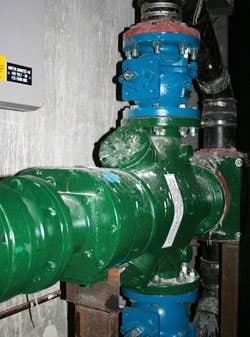Vegas Detention Center Proves Monsters are Everywhere
Before the first Muffin Monster grinder was installed, Clark County Detention Center (CCDC) had no effective way of reducing waste in the effluent wastewater being received at the City of Las Vegas Water Pollution Control Facility (WPCF). According to Lloyd Noffsinger, maintenance and operations supervisor for CCDC since 1984, WPCF staff was continually contacting his office to find out how certain items were ending up in their facility. Unfortunately, CCDC needed funding to support any new wastewater projects.
When the CCDC was originally built in 1984, it was a 12-story building, designed with 1,450 beds. An expansion of the center was finished in 2002, adding 320,000 sq ft and 1,300 beds. CCDC processes approximately 59,000 bookings per year from 30 local and state agencies, resulting in an average of 2,700 inmates housed at the center daily. The center has a staff of approximately 3,000. With this increase of housing space and activity, the detention center faced the challenge of keeping effluent wastewater moving without any clogs in the facility’s lift station or large solids passing to the city wastewater facility.
The first grinder, positioned underground between the booking building and parking structure, successfully reduced wastewater solids. CCDC installed five more and, as Noffsinger pointed out, he is reviewing his budget for the installation of a Macho Monster. “There is little to no maintenance, only yearly checks on the cutter wear and torque, required to keep the grinders running smoothly and clog-free,” Noffsinger said.
As Dick Schalberg, JWC representative from Misco Water–Southwest in Henderson, Nev., pointed out, “One of the most unique points about this facility is the ‘creative’ Muffin Monster installations they require.” Since the building expansion only allowed for one grinder, CCDC was left with the task of finding space to install additional ones.
Of the six grinders, three are underground, one is installed horizontally in a very narrow closet, a larger grinder is hoisted up on a steel support about 5 ft off the ground and, the most interesting—a grinder suspended from the ceiling in the laundry area. Four of the grinders process wastewater from specific areas, and all the grinders are equipped with their own PLC control panel.
Along with JWC’s ability to accommodate the many custom installations, Noffsinger said, “I am most impressed with the customer support at JWC. All my questions were answered quickly and efficiently.” JWC Muffin Monsters were chosen as a result of the successful operation of Muffin Monsters installed in the Clark County Government Building in Laughlin, Nev., also a facility of the CCDC.
The dual-shafted Muffin Monster grinds a wider variety of solids than single-shafted machines while its low-speed operation results in higher torque and fewer interrupts. Its special cutter teeth were developed specifically for grinding large solids into smaller particles.
Muffin Monster grinders effectively reduce the particle size of wood, clothing, plastics, rocks, sludge and other foreign material that would otherwise foul, clog or damage waste stream and process equipment, typically reducing the handling costs associated with solids removal.
The grinder adapts to most applications with little or no modification to piping, channel or power, and offers high pressure—90 psi (6 bars) capability, with no seal flush required and no packing gland to adjust.
